High-Resolution X-ray Phase-Contrast Imaging and Sensory and Rheometer Tests in Cooked Edamame
Abstract
:1. Introduction
2. Materials and Methods
2.1. Sample Preparation
2.2. Sensory Evaluation Tests and Rheological Analysis
2.3. X-ray Phase-Contrast CT
2.4. Absorption Based X-ray CT
3. Results
3.1. Sensory Characteristics and Rheological Analyses of Edamame Beans
3.2. Visualization of Microstructure of Edamame Beans by X-ray Phase-Contrast CT
3.3. Density Distribution in Edamame Beans by X-ray Phase-Contrast CT
4. Discussion
5. Concluding Remarks
Supplementary Materials
Author Contributions
Funding
Acknowledgments
Conflicts of Interest
References
- Ikeda, H.; Shibuya, T.; Imanishi, S.; Aso, H.; Nishiyama, M.; Kanayama, Y. Dynamic metabolic regulation by a chromosome segment from a wild relative during fruit development in a tomato introgression line, IL8-3. Plant Cell Physiol. 2016, 57, 1257–1270. [Google Scholar]
- Sagor, G.H.M.; Berberich, T.; Tanaka, S.; Nishiyama, M.; Kanayama, Y.; Kojima, S.; Muramoto, K.; Kusano, T. A novel strategy to produce sweeter tomato fruits with high sugar contents by fruit-specific expression of a single bZIP transcription factor gene. Plant Biotechnol. J. 2016, 14, 1116–1126. [Google Scholar]
- Tsunoda, Y.; Hano, S.; Imoto, N.; Shibuya, T.; Ikeda, H.; Amagaya, K.; Kato, K.; Shirakawa, H.; Aso, H.; Kanayama, Y. Physiological roles of tryptophan decarboxylase revealed by overexpression of SlTDC1 in tomato. Sci. Hortic. 2021, 275, 109672. [Google Scholar]
- Shibuya, T.; Watanabe, T.; Ikeda, H.; Kanayama, Y. Ionomic analysis of horticultural plants reveals tissue-specific element accumulation. Hort. J. 2015, 84, 305–313. [Google Scholar]
- Contador, L.; Shinya, P.; Infante, R. Texture phenotyping in fresh fleshy fruit. Sci. Hortic. 2015, 193, 40–46. [Google Scholar]
- Furutani, N.; Nomura, S.; Ohtani, K.; Matsui, M. Development of palatability estimation method in green soybeans of Tamba black soybean. Hort. Res. (Jpn.) 2012, 11, 309–314, (In Japanese with English Abstract). [Google Scholar]
- Szczesniak, A.S. Texture is a sensory property. Food Qual. Prefer. 2002, 13, 215–225. [Google Scholar]
- Schoeman, L.; Williams, P.; du Plessis, A.; Manley, M. X-ray micro-computed tomography (mCT) for non-destructive characterisation of food microstructure. Trends Food Sci. Technol. 2016, 47, 10–24. [Google Scholar]
- Herremans, E.; Verboven, P.; Bongaers, E.; Estrade, P.; Verlinden, B.E.; Wevers, M.; Hertog, M.L.A.T.M.; Nicolai, B.M. Characterisation of ‘Braeburn’ browning disorder by means of X-ray micro-CT. Postharvest Biol. Technol. 2013, 75, 114–124. [Google Scholar]
- Nugraha, B.; Verboven, P.; Janssen, S.; Wang, Z.; Nicolai, B.M. Non-destructive porosity mapping of fruit and vegetables using X-ray CT. Postharvest Biol. Technol. 2019, 150, 80–88. [Google Scholar]
- Pittia, P.; Sacchetti, G.; Mancini, L.; Voltolini, M.; Sodini, N.; Tromba, G.; Zanini, F. Evaluation of microstructural properties of coffee beans by synchrotron X-ray microtomography: A methodological approach. J. Food Sci. 2011, 76, E222–E231. [Google Scholar]
- Flores, D.; Giovanni, M.; Kirk, L.; Liles, G. Capturing and explaining sensory differences among organically grown vegetable-soybean varieties grown in northern California. J. Food Sci. 2019, 84, 613–622. [Google Scholar]
- Wszelaki, A.L.; Delwiche, J.F.; Walker, S.D.; Liggett, R.E.; Miller, S.A.; Kleinhenz, M.D. Consumer liking and descriptive analysis of six varieties of organically grown edamame-type soybean. Food Qual. Prefer. 2005, 16, 651–658. [Google Scholar]
- Akazawa, T.; Shiraiwa, E.; Satoh, N.; Sasahara, T. Variations in eating quality, flavor and od color of green soybeans from vegetable-type and grain-type plants stored at various temperatures. Jpn. J. Crop Sci. 2002, 71, 62–67, (In Japanese with English Abstract). [Google Scholar]
- Masuda, R.; Hashizume, K.; Kaneko, K. Effect of holding time before freezing on the constituents and the flavor of frozen green soybeans (edamame). Nippon Shokuhin Kogyo Gakkaishi 1988, 35, 763–770, (In Japanese with English Abstract). [Google Scholar]
- Furutani, N.; Ogawa, T.; Mimura, Y.; Yamasaki, M. Breeding of new green soybeans of Tamba black soybean varieties, ‘Murasakizukin 3 gou’. Hort. Res. (Jpn.) 2015, 14, 403–408, (In Japanese with English Abstract). [Google Scholar]
- Kitchen, M.J.; Buckley, G.A.; Gureyev, T.E.; Wallace, M.J.; Andres-Thio, N.; Uesugi, K.; Yagi, N.; Hooper, S.B. CT dose reduction factors in the thousands using X-ray phase contrast. Sci. Rep. 2017, 7, 15953. [Google Scholar]
- Croton, L.C.P.; Morgan, K.S.; Paganin, D.M.; Kerr, L.T.; Wallace, M.J.; Crossley, K.J.; Miller, S.L.; Yagi, N.; Uesugi, K.; Hooper, S.B.; et al. In situ phase contrast X-ray brain CT. Sci. Rep. 2018, 8, 11412. [Google Scholar]
- Kijima., N.; Sunaoshi, R.; Masaka, T.; Ishikawa, D.; Fujii, T. Elastic and rupture analysis on food gels. Nippon Shokuhin Kagaku Kogaku Kaishi 2020, 67, 217–229, (In Japanese with English Abstract). [Google Scholar]
- R Core Team. R: A Language and Environment for Statistical Computing; Version 4.1.2; R Foundation for Statistical Computing: Vienna, Austria, 2021; Available online: https://www.R-project.org (accessed on 24 January 2022).
- Hothorn, T.; Hornik, K. exactRankTests: Exact Distributions for Rank and Permutation Tests; R Package Version 0.8-34; R Foundation for Statistical Computing: Vienna, Austria, 2021; Available online: https://CRAN.R-project.org/package=exactRankTests (accessed on 24 January 2022).
- Momose, A.; Kawamoto, S.; Koyama, I.; Hamaishi, Y.; Takai, K.; Suzuki, Y. Demonstration of X-ray Talbot interferometry. Jpn. J. Appl. Phys. 2003, 42 Pt 2, L866–L868. [Google Scholar]
- Momose, A. Recent advances in X-ray phase imaging. Jpn. J. Appl. Phys. 2005, 44 Pt 1, 6355–6367. [Google Scholar]
- Hoshino, M.; Uesugi, K.; Yagi, N.; Mohri, S.; Regini, J.; Pierscionek, B. Optical properties of in situ eye lenses measured with X-ray Talbot interferometry: A novel measure of growth process. PLoS ONE 2011, 6, e25140. [Google Scholar]
- Hoshino, M.; Uesugi, K.; Yagi, N. 4D x-ray phase contrast tomography for repeatable motion of biological samples. Rev. Sci. Instrum. 2016, 87, 093705. [Google Scholar]
- Rueden, C.T.; Shindelin, J.; Hiner, M.C.; DeZonia, B.E.; Walter, A.E.; Arena, E.T.; Eliceiri, K.W. ImageJ2: ImageJ for the next generation of scientific image data. BMC Bioinform. 2017, 18, 529. [Google Scholar]
- Schindelin, J.; Arganda-Carreras, I.; Frise, E.; Kaynig, V.; Longair, M.; Pietzsch, T.; Preibisch, S.; Rueden, C.; Saalfeld, S.; Schmid, B.; et al. Fiji: An open-source platform for biological-image analysis. Nat. Methods 2012, 9, 676–682. [Google Scholar]
- Miller, S.S.; Bowman, L.A.; Gijzen, M.; Miki, B.L.A. Early development of the seed coat of soybean (Glycine max). Ann. Bot. 1999, 84, 297–304. [Google Scholar]
- Karunakaran, C.; Lahlali, R.; Zhu, N.; Webb, A.M.; Schmidt, M.; Fransishyn, K.; Belev, G.; Wysokinski, T.; Olson, J.; Cooper, D.M.L.; et al. Factors influencing real time internal structural visualization and dynamic process monitoring in plants using synchrotron-based phase contrast X-ray imaging. Sci. Rep. 2015, 5, 12119. [Google Scholar]
- Brodersen, C.R.; McElrone, A.J.; Choat, B.; Lee, E.F.; Shackel, K.A.; Matthews, M.A. In vivo visualizations of drought-induced embolism spread in Vitis vinifera. Plant Physiol. 2013, 161, 1820–1829. [Google Scholar]
- Nardini, A.; Savi, T.; Losso, A.; Petit, G.; Pacilè, S.; Tromba, G.; Mayr, S.; Trifilò, P.; Gullo, M.A.L.; Salleo, S. X-ray microtomography observations of xylem embolism in stems of Laurus nobilis are consistent with hydraulic measurements of percentage loss of conductance. New Phytol. 2017, 213, 1068–1075. [Google Scholar]
- Fatima, A.; Kataria, S.; Guruprasad, K.N.; Agrawal, A.K.; Singh, B.; Sarkar, P.S.; Shripathi, T.; Kashyap, Y.; Sinha, A. Synchrotron X-ray phase contrast imaging of leaf venation in soybean (Glycine max) after exclusion of solar UV (280–400 nm) radiation. J. Synchrotron Radiat. 2016, 23, 795–801. [Google Scholar]
- Mahajan, S.; Mittal, S.K.; Das, A. Machine vision based alternative testing approach for physical purity, viability and vigour testing of soybean seeds (Glycine max). J. Food Sci. Technol. 2018, 55, 3949–3959. [Google Scholar]
- Moriwaki, S.; Terada, Y.; Kose, K.; Haishi, T.; Sekozawa, Y. Visualization and quantification of vascular structure of fruit using magnetic resonance microimaging. Appl. Magn. Reson. 2014, 45, 517–525. [Google Scholar]
- Yooyongwech, S.; Horigane, A.K.; Yoshida, M.; Yamaguchi, M.; Sekozawa, Y.; Sugaya, S.; Gemma, H. Changes in aquaporin gene expression and magnetic resonance imaging of water status in peach tree flower buds during dormancy. Physiol. Plant. 2008, 134, 522–533. [Google Scholar]
- Yooyongwech, S.; Horigane, A.K.; Yoshida, M.; Sekozawa, Y.; Sugaya, S.; Cha-Um, S.; Gemma, H. Hydrogen cyanamide enhances MRI-measured water status in flower buds of peach (Prunus persica L.) during winter. Plant Omics 2012, 5, 400–404. [Google Scholar]
- Gargiulo, L.; Sorrentino, G.; Mele, G. 3D imaging of bean seeds: Correlations between hilum region structures and hydration kinetics. Food Res. Int. 2020, 134, 109211. [Google Scholar]
- Miller, S.S.; Jin, Z.; Schnell, J.A.; Romero, M.C.; Brown, D.C.W.; Johnson, D.A. Hourglass cell development in the soybean seed coat. Ann. Bot. 2010, 106, 235–242. [Google Scholar]
- Sood, S.; Mahajan, S.; Doegar, A.; Das, A. Internal Crack Detection in Kidney Bean Seeds Using X-ray Imaging Technique. In Proceedings of the International Conference on Advances in Computing, Communications and Informatics (ICACCI), Jaipur, India, 21–24 September 2016; pp. 2258–2261. [Google Scholar]
- Divekar, M.T.; Karunakaran, C.; Lahlali, R.; Kumar, S.; Chelladurai, V.; Liu, X.; Borondics, F.; Shanmugasundaram, S.; Jayas, D.S. Effect of microwave treatment on the cooking and macronutrient qualities of pulses. Int. J. Food Prop. 2017, 20, 409–422. [Google Scholar]
- Mizuno, H.; Tanaka, N.; Hashimoto, S.; Yamamoto, T.; Nakano, R.; Ushijima, K.; Kubo, Y. Effect of gelatinization degree before freezing on the physical properties of green soybean ‘Miryoku’ and ‘Yuagari-musume’. Jpn. J. Food Eng. 2015, 16, 63–70, (In Japanese with English Abstract). [Google Scholar]
- Hiwasa, K.; Nakano, R.; Hashimoto, A.; Matsuzaki, M.; Murayama, H.; Inaba, A.; Kubo, Y. European, Chinese and Japanese pear fruits exhibit differential softening characteristics during ripening. J. Exp. Bot. 2004, 55, 2281–2290. [Google Scholar]
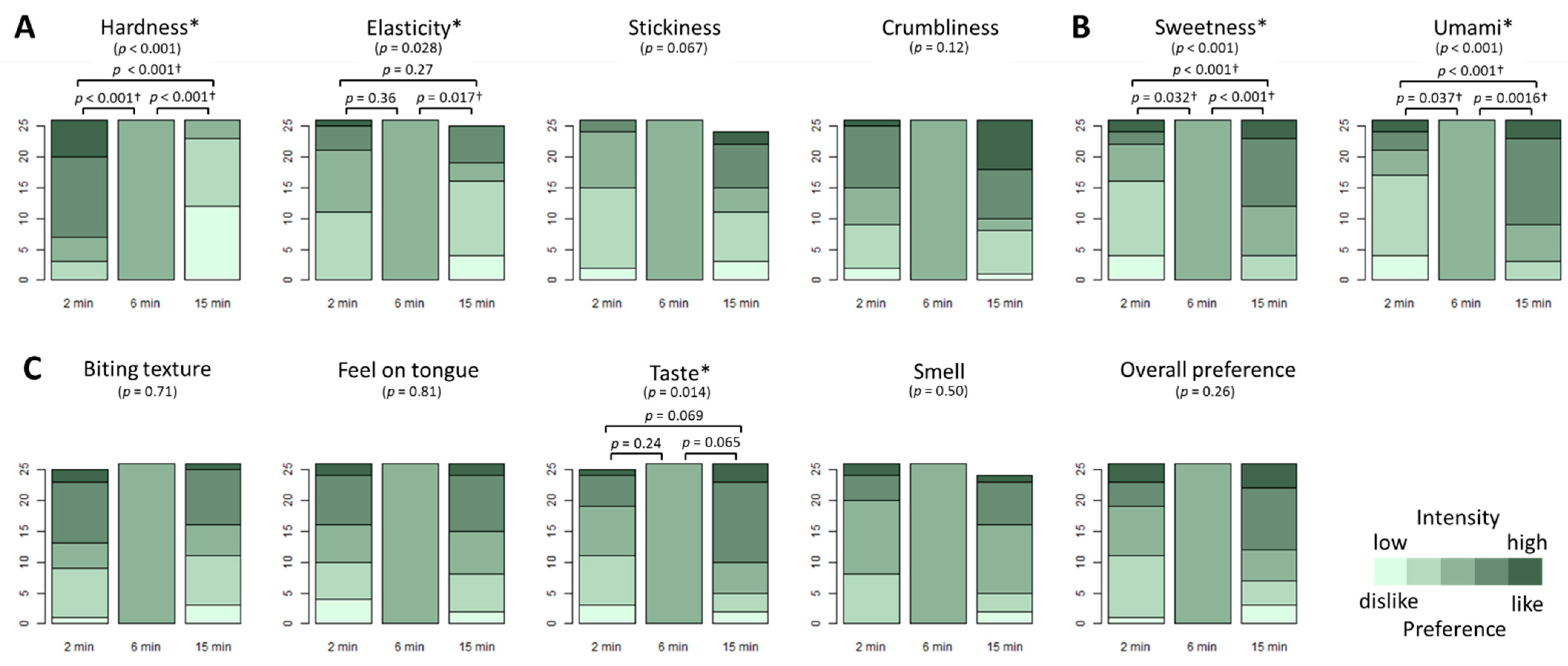
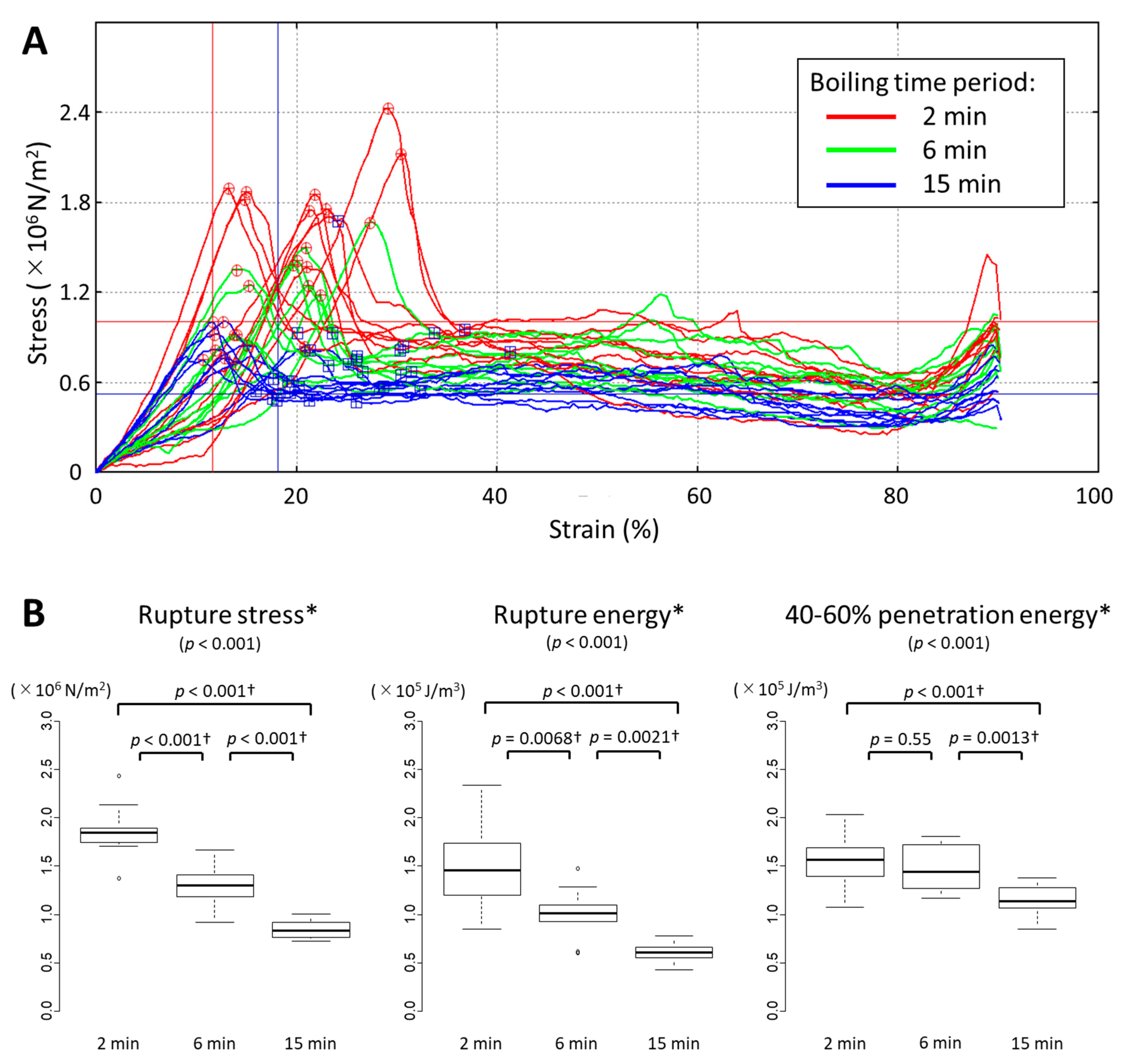
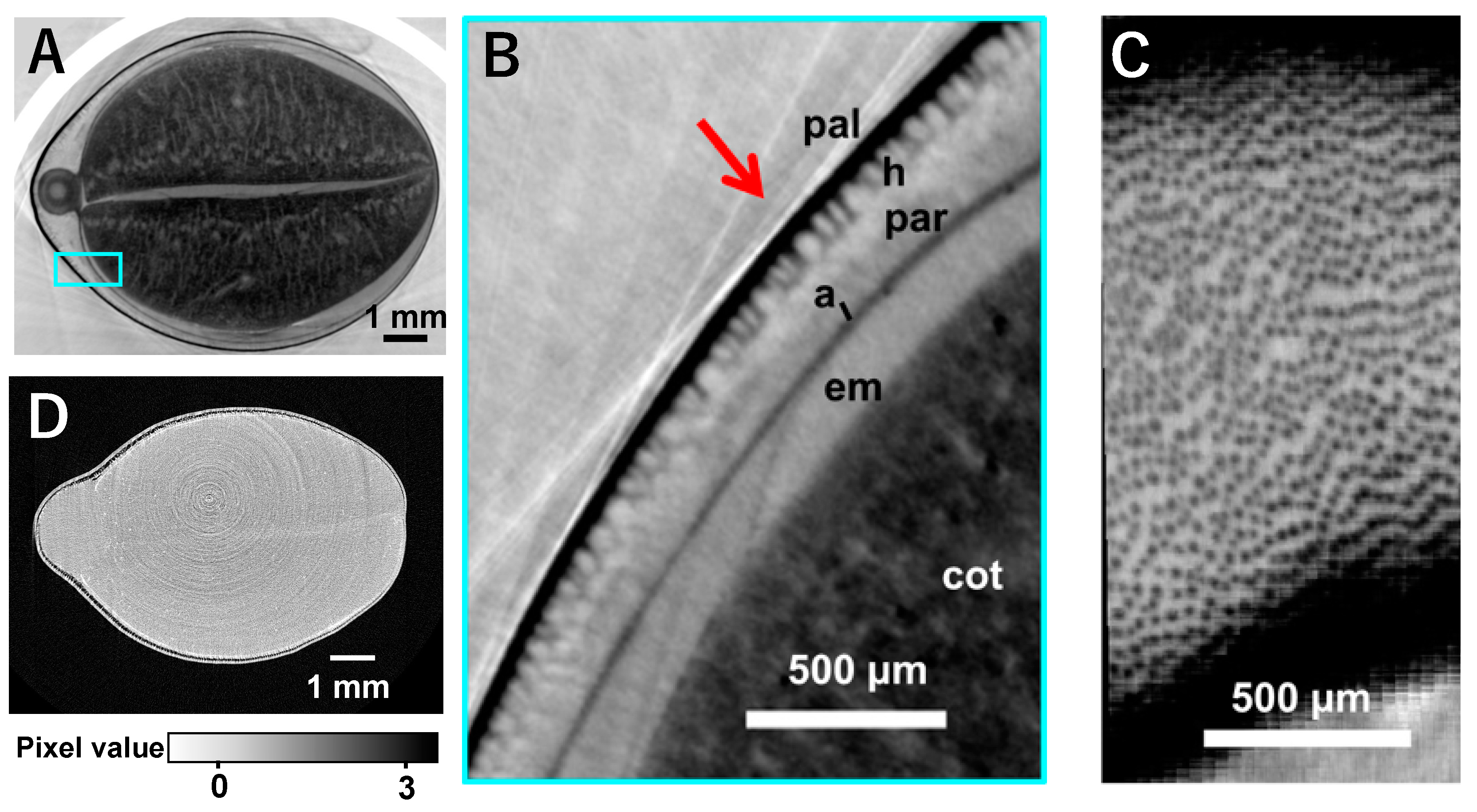
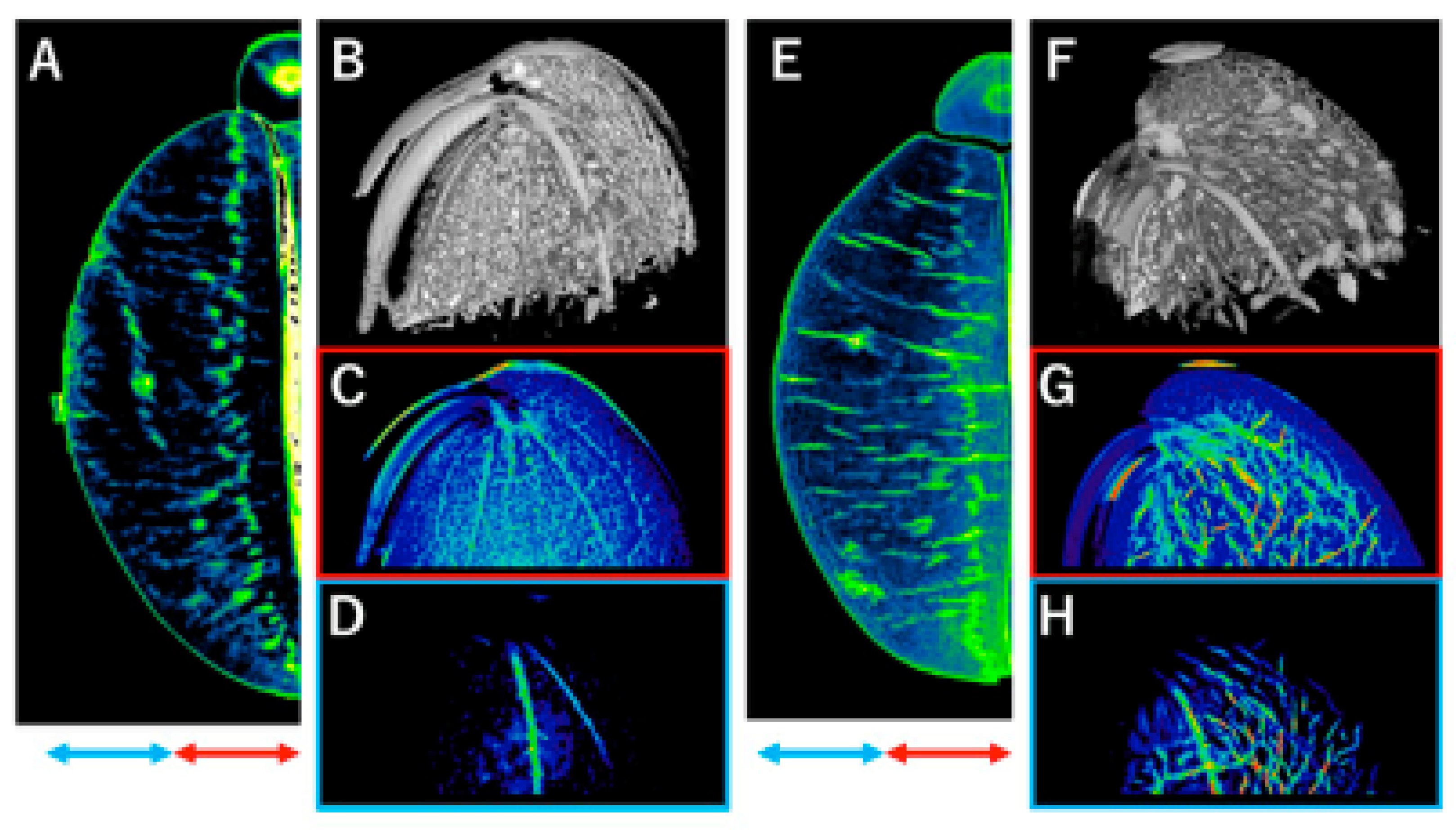
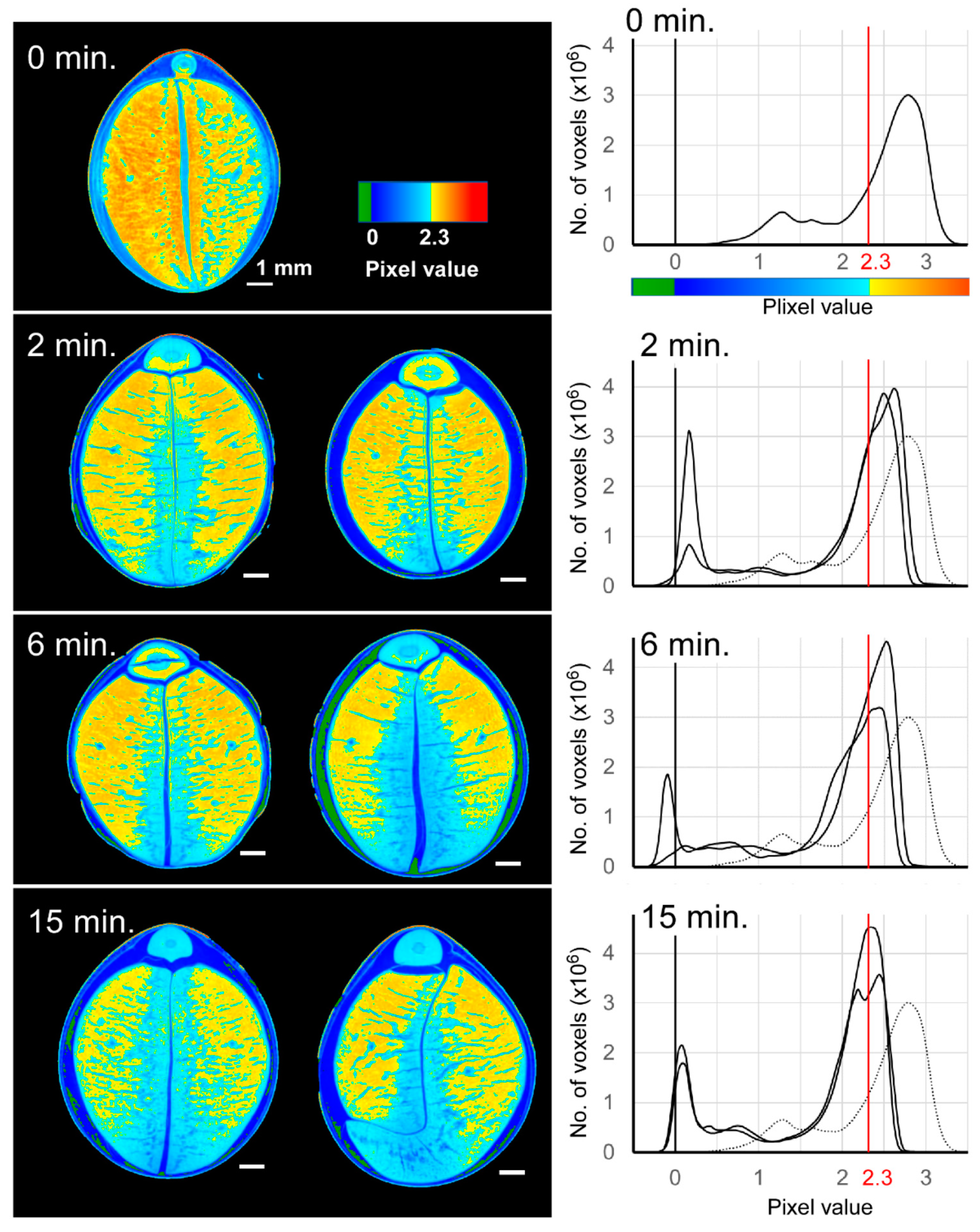
Publisher’s Note: MDPI stays neutral with regard to jurisdictional claims in published maps and institutional affiliations. |
© 2022 by the authors. Licensee MDPI, Basel, Switzerland. This article is an open access article distributed under the terms and conditions of the Creative Commons Attribution (CC BY) license (https://creativecommons.org/licenses/by/4.0/).
Share and Cite
Hidaka, M.; Miyashita, S.; Yagi, N.; Hoshino, M.; Kogasaka, Y.; Fujii, T.; Kanayama, Y. High-Resolution X-ray Phase-Contrast Imaging and Sensory and Rheometer Tests in Cooked Edamame. Foods 2022, 11, 730. https://doi.org/10.3390/foods11050730
Hidaka M, Miyashita S, Yagi N, Hoshino M, Kogasaka Y, Fujii T, Kanayama Y. High-Resolution X-ray Phase-Contrast Imaging and Sensory and Rheometer Tests in Cooked Edamame. Foods. 2022; 11(5):730. https://doi.org/10.3390/foods11050730
Chicago/Turabian StyleHidaka, Masafumi, Shuhei Miyashita, Naoto Yagi, Masato Hoshino, Yukiya Kogasaka, Tomoyuki Fujii, and Yoshinori Kanayama. 2022. "High-Resolution X-ray Phase-Contrast Imaging and Sensory and Rheometer Tests in Cooked Edamame" Foods 11, no. 5: 730. https://doi.org/10.3390/foods11050730
APA StyleHidaka, M., Miyashita, S., Yagi, N., Hoshino, M., Kogasaka, Y., Fujii, T., & Kanayama, Y. (2022). High-Resolution X-ray Phase-Contrast Imaging and Sensory and Rheometer Tests in Cooked Edamame. Foods, 11(5), 730. https://doi.org/10.3390/foods11050730





